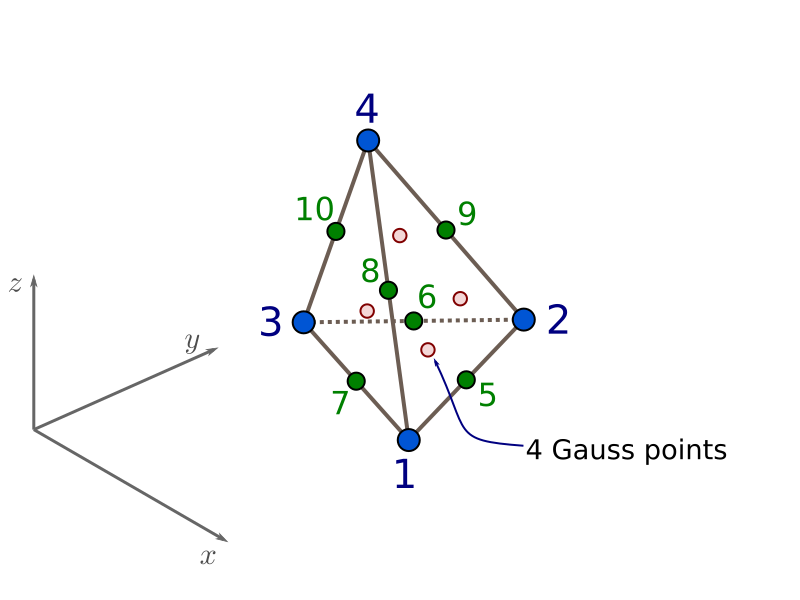TenNodeTetrahedron#
This command is used to construct an ten-node tetrahedron, which uses the standard isoparametric formulation.
- Model.element("TenNodeTetrahedron", tag, nodes, material, *args)#
- Parameters:
tag – integer tag identifying the element
nodes – tuple of integer tags identifying the nodes that form the element
material – integer tag identifying the nDMaterial
args – optional arguments
kwargs – optional keyword arguments
- element TenNodeTetrahedron $tag $node1 $node2 $node3 $node4 $node5 $node6 $node7 $node8 $node9 $node10 $matTag <$b1 $b2 $b3> <doInitDisp?>
Argument |
Type |
Description |
|---|---|---|
$tag |
integer |
unique element object tag |
$node1 .. $node10 |
10 integer |
nodes of tet (ordered as shown in fig below) |
$matTag |
integer |
tag of nDMaterial |
$b1 $b2 $b3 |
list float |
optional: body forces in global x y z directions |
<-doInitDisp $value> |
optional: consider initial displacements if $value is 0 |
This element is based on second-order interpolation of nodal quantities, this means that the strain and stress field inside the element are linearly interpolated. Four Gauss-points inside the element are used for integration.

Fig. 37 TenNodeTetrahedron Element Node Numbering#
Note
The valid queries to a TenNodeTetrahedron element when creating an ElementRecorder object are ‘forces’, ‘stresses,’ (‘strains’ version > 2.2.0) and ‘material $matNum matArg1 matArg2 …’ Where $matNum refers to the material object at the integration point corresponding to the node numbers in the isoparametric domain.
This element can only be defined after a model with -ndm 3 -ndf 3
Example
The following example constructs a TenNodeTetrahedron element with tag 1 between nodes 1, 2, 3, 4, 5, 6, 7, 8, 9, 10 with an nDMaterial of tag 1 and body forces given by varaiables b1, b2, b3.
Tcl Code
element TenNodeTetrahedron 1 1 2 3 4 5 6 7 8 9 10 1 $b1 $b2 $b3
Python Code
model.element('TenNodeTetrahedron',1, (1,2,3,4,5,6,7,8,9,10), 1, (b1, b2, b3))
Code Developed by: José Antonio Abell and José Luis Larenas (UANDES). For bugs and features, start a new issue on the OpenSees github repo and tag me (@jaabell).